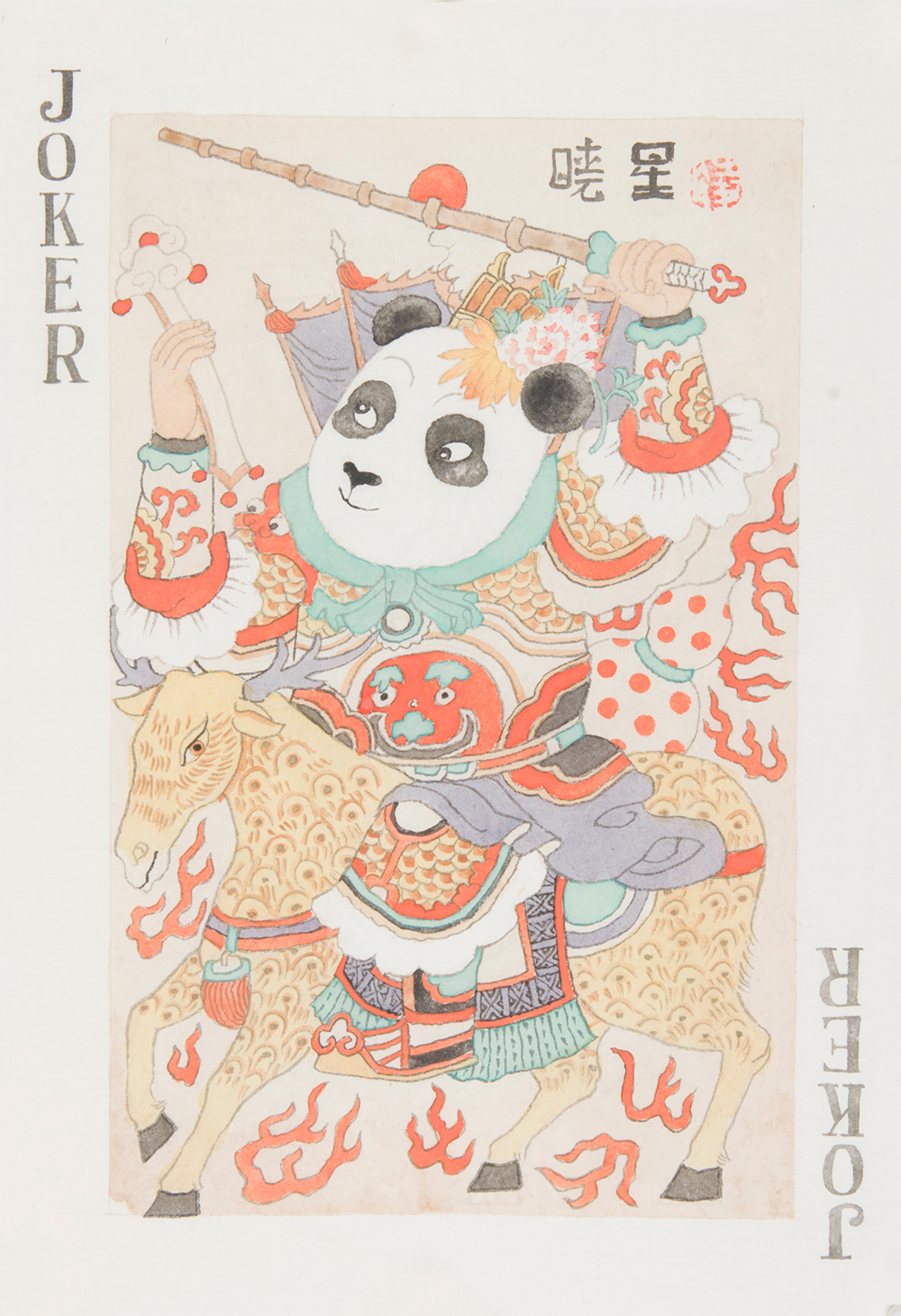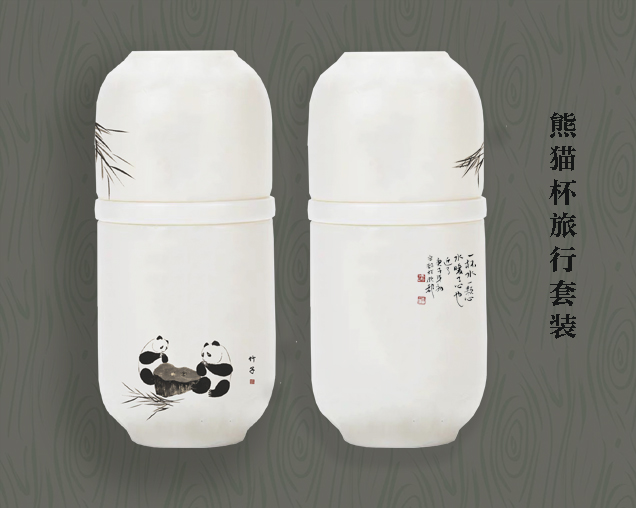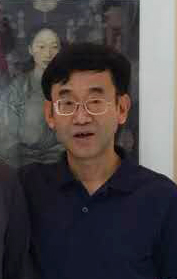意识的构架——唐华伟的画
时间:2016-01-11 | 来源:王栋栋 |
黑夜的大道向前方无限延伸,两旁的植物在空间的缝隙中自足生长,远空的星星深邃得只能显现出微微地闪烁,这是唐华伟的油画《仲夏夜》中的“场景”。当然,与其说是场景,不如说是场景的构架,更不如说是艺术家对场景的意识的构架,作者并没有给予画面以一般再现式的图像,而是尽可能以抽象的方式对景象以梳理,并有控制地自由表现出自我意识中的势头——他试图以绘画的方式去触接日常世界里最普遍的生命力,希望用艺术家的感知力唤醒视觉的声音和形式的语言,使其保持一种“鲜活”的状态。
艺术家是一个有超强感知力的群体,只有这样,它才能在日常世界中淘取出非日常的意义。
虽然说,我们生活在一个意义丰富的世界,但是,我们看到的世界远没有世界本身丰富,或者说,我们用日常经验所捕获的意义仅仅是世界微不足道的部分。可见,作为社会的人本身是渺小和微不足道的,遗憾的是,正因为这些局限,我们为了掩盖自己的弱小而导致的自卑,我们不计后果地制造了各种各样的道德光环来维护自己自卑的外壳——“尊严”,于是,世界的丰富性被我们简化成单调的表皮,我们只相信“眼见为实”,以致于我们把自我独立在世界之外,并生搬硬套地搭建了一个“唯物主义”的表象世界,从此,我们脱离了对自我意识的鲜活反应,特别是在那些人文主义教育先天不足的社会,大部分的人们拖着“唯物主义”的皮肉,无意识地穿行在世界上,人们无异于是在用四肢控制大脑,这样的社会不仅充满暴力、缺乏同情,而且缺乏真正的观看和认识,同时也就决定了这样的社会缺乏主体的反思能力,无从调节人和世界的本来关系。显然,在这样思维和存在都极度粗糙的社会里,那些实用主义的逻辑和方法都只是一种临时的兴奋剂,也许,只有那些不实用的行为(比如艺术)才能对人的本来状态起到一些重新追溯的作用。
可以说,在人类的所有学科中,只有艺术是最直接强调本真的。艺术的行为是从日常行为到非日常行为的去蔽的过程,是一种通向精神性的劳动。去蔽则需要抛弃被虚伪包裹的部分,同时需要建构起去伪之后的对“空缺”的适应,这种空缺是无限的空间和时间,它由生命的能量组成,但它不在视网膜的一般感应之下,而存在于人的整体知觉感应中。所以,好的艺术一般不再现日常的事实,而宁愿把现实的积极能量转化到对“空缺”(虚空)的建构中,这也是对生命的重建。在这个层面上,我们也就不难理解艺术家唐华伟在艺术中对意识构架的探寻。
世界首先是一幅巨大无比的画,画家首先是一个观看者,无疑,只有会看画的人才能画好画。如何看画(世界)?当然不只是用眼睛看!画画其实是对生存过程中某些隐秘问题的揭示,是对不可见之物的观看。优秀的画家就像上帝派到地球上的间谍,专门打探这里的关键问题,比如:人们在接受某些新闻事件的同时过滤了哪些自己真实的想法、社会在运转过程中埋没了多少超越时代的创造力、潮流如何从个体的念头转化成社会风靡的对象,等等,艺术就是用来发现真实的,艺术家就是一个决定如何发现真实并实施行为的人。在中国传统绘画中就强调心、眼、手的协同发挥,重视调动主体丰富的身体感知力,按照今天人的话说,就是要以认知的态度来对待绘画,要在绘画中展现纵深的空间意识,并以创造性的语言去触及不可见之处。如果说唐华伟的画《仲夏夜》是一幅风景画,不如说是一幅内心的风景画,大道两旁的植物并没有表现出自身的常态,我们看到的植物更多是一种生长的态势。
唐华伟的画没有一般绘画的叙事性,他更注重心性的表达,同时以理性的思维去统摄物质性的语言、形式与意识性的感知之间的关系。从创作特征来看,既有分析性绘画的严谨,也有传统书画中书写性的灵活,所以,他的画始终不像关于世界现象的描绘,而是一种“体内风景”(即由意识过程接触到的关于物质世界体内的状态)。一般来讲,我们能意识到的世界会比我们看到的世界大一些,但仍然只是世界的一小部分,但意识有一个能力,就是无限流动和通达的能力,在理论上它又有着通达整个世界的可能性。意识就像是世界的电波,意识的存在就如同物质存在的构架,只有构架存在才有对本源世界进行追溯的可能。那么艺术家的创作就好比是在对意识存在进行构架的呈现,这样也就从生活的日常过程中开启了对本源世界追溯的可能。
《仲夏夜》、《夜路》、《月光下》等作品中,我们还可以勉强将那些缠绕的线条视作植物形状,但在《秋的像》、《余辉》、《纠结的网》、《云中月》等作品中则以抽象的线条为主,线条成为独立的形式,线条就是线条本身,线条本身大于其他一切的日常中可识别的外形和叙事。实际上,绘画的本质是形式创造——即对意识过程的经验性捕捉,并对其进行视觉性呈现(这个呈现与一般的再现不同,可以说是对意识过程的某种再现,但更多是对意识是如何产生的这个问题的创造性阐释),反映的是某种生命的本质。生命本身是永不停息的,它往往会在不同的事物和不同的时间以不同形式交替转换和流变,所以,生命过程中的任何间歇性状态都是复杂的,就如同人生的矛盾,永远有解不开的结。但是,这种结却蕴藏着巨大的力量,它象征着爆发前的复杂动机。在现实生活中的爆发状态往往意味着某种破坏的可能,但艺术形式中的“破坏”却意味着彻底的开放和无限的自由在呼唤。可见,唐华伟作品中这些纠缠着的线条蕴含着主体对自由的呼唤的能量。
这些线条具有自身独立的美学特征,从中国传统美学来讲,好的艺术中应该包含丰富的时间因素,从西方美学来讲,艺术中应该包含理念(可以理解为认知的空间),依照康德对时间和空间的理解,时间是内感官形式,一切外部现象都要纳入内部来感知。再来看唐华伟的画,其间可谓包含了各种形式的时间。唐华伟喜欢画大画,讲究画画的功力,过程中保持自然、轻快、果断,用从容的内心来调节状态,所以,他把画大画视为烹小鲜,这反映了一种控制力——一种相对自由状态下的主体创造能力。创造需要保持对意识流动过程的一定程度上的克制,尽管他强调快意书写,但一直警惕轻率,并动用多种语言方式实现画面的丰富的感知维度。他习惯多用油画刀,将多层次的色彩从外层往内层画,在不可预知的效果中维护画面的秩序,在这些可控制又灵活的绘制实践中创造了丰富的细节和环环相扣的关系,可谓实现了从外感官的空间到内感官的时间的意识的构架。
对人的意识的探讨是对人自身的重视,我们生存的世界是一个日益世俗并不断遮蔽本真的现象实体,作为社会的人,虽然需要积极地建构起合理的社会,但对内心的建构同等重要,所以我们需要在各种实用主义学科和精神性学科中保持平衡,才能让人生具有存在的意义。拿一些哲学家的话来说,生命是一种想象,但是,生命更是一种理性的建构。唐华伟一直力图使自己的画实现“鲜活”的状态,以语言的创造对应生命的流动,这无疑就是对生命的建构,而那画中的“意识的构架”则是精神的肖像——一个定格的世界,一种通向自在之物过程中必不可少的直观形式。
The Framework of Awareness
--Tang Huawei’s Paintings
By Wang Dongdong
The road runs under night sky, forward into the darkness, along which plants are growing in their own space, and above which stars are only dimly twinkling high in the sky. This is the “scene” of Tang Huawei’s oil painting—Midsummer Night. Indeed, it is rather a framework of the scene than being the scene itself, or it is actually the framework of the artist’s awareness of the scene. The artist didn’t depict the usual reproduction of the scene, but tried his best to comb through the scene in an abstract way, and express the momentum of self-awareness in a controlled manner. He was trying to associate the commonest vitality in daily life by painting, and expecting to awaken the visual sound and formal language with an artist’s perception, to keep them in a “fresh and lively” state.
Artists are usually a group with super strong perception, with which they could extract non-daily meanings from daily world.
Although we live in a world with rich meanings, the world in our eyes does not appear to be as rich as it actually is, or, the meanings captured by us with our daily experience are only a negligible part of the real world. It is thus clear that mankind in society is small and insignificant in itself, but pitifully, we created various moral halos to cover up our inferiority complex originating from our intrinsic weakness and limitations, regardless of the possible consequence, i.e. our so-called “dignity”. Therefore, the rich world is reduced by us into a monotonous superficial one. We only believe in “seeing,” leading to our separating ourselves from the world, and establishing a superficial “materialistic” world mechanically. From then on, we are deprived of an immediate response to self-awareness, especially in societies inherently short of humanistic education. Most people, in their “materialistic” body, travel through the world unconsciously. They are a manipulating brain with four limbs. Such a society not only floods with violence, lacks sympathy, but also lacks true observation and cognition, which jointly lead to the absence of the main subject’s capacity in reflection, and failure in regulating the original relationship between man and nature. Apparently, in a society filled with extremely unrefined thinking and existence, the logic of pragmatism and method are all temporary stimulants. Probably, only the non-practical behaviors (such as art) can resurrect the intrinsic state of human being in a sense.
It is said that only art, among all subjects, most directly emphasizes authenticity. Artistic behavior is a “de-flawing” process from daily behavior to non-daily behavior, a work targeting the spirit. “De-flawing” requires abandoning the parts covered by hypocrisy, and acclimatizing to the “absence of disguise” afterwards. Such an absence means infinite time and space, which consists of the energy of life, but exists in human awareness and response, beyond the sense of retinas. Therefore, excellent art never reproduces daily reality, but rather applies active energy in reality to the construction of “absence” (emptiness), which is also the re-construction of life. In this sense, it is not hard to understand the artist, Tang Huawei’s artistic exploration in framework of awareness.
The world is an incomparably huge painting in the first place, and the painter is the first observer. Undoubtedly, only the person good at discovering can paint well. How do we observe a painting (the world)? Certainly not only with our eyes! A painting is actually revealing some hidden problems in the process of human existence, and observing the invisible. Excellent painters are agents assigned by God to the earth, spying for the key problems here, such as what true thoughts are filtrated when people are receiving some news and events? How much creativity beyond times is submerged in the operation of society? How can a trend be transformed from an individual idea into social popularity, etc. Art is for finding authenticity, and the artist is the very person who decides how to find the authenticity and take action. Traditional Chinese painting emphasizes the coordinated action of mind, eyes and hands, and the rich perception of the main subject’s body. Today, we emphasize cognitive attitudes towards painting, in-depth spatial awareness in painting and creative language to touch the invisible part. Tang Huawei’s Midsummer Night is rather a mental landscape than a pure landscape, since the plants along the road do not appear in a normal state, but present a growing trend.
Tang Huawei’s paintings lack ordinary narration, but focus on the expression of mentality, and controls the relationship among materialized language, form and conscious perception with rational thinking. In terms of creative characteristics, they combine the preciseness of analytical painting with the flexibility of traditional handwriting and painting. Therefore, his paintings do not depict the world’s phenomena, but depict “intra-world landscapes” (the state inside the material world known in the process of awareness). Usually, the world we are aware of is larger than the one we see, but still it is only a small part of the world. However, awareness has the ability of limitless flow and communication, and theoretically, it has the possibility of communication with the whole world. Like the radio waves of the world, awareness exists as the framework of material existence. Only with the existing framework, is there the possibility of tracking the original world. An artist’s creation is just materializing the framework of awareness, and enabling the tracking of the original world in daily life.
In Midsummer Night, Night Road and Under the Moonlight, we could manage to consider the entangled lines as plants. But in the Image of Autumn, Afterglow, Intertwined Net and Moon in Clouds, abstract lines dominate the paintings in independent form, and lines stand for lines themselves, going beyond any recognizable shape and narration in daily life. In fact, painting is to create form in nature; it is to capture the process of awareness with experience and to visually demonstrate the process (The demonstration, different from normal reproduction, can be considered as a certain reproduction of the process of awareness, but it is more like a creative explanation of how awareness is generated), reflecting a certain nature of life. Life is restless, and often alternating, transforming and changing among different matters, time and forms. Therefore, any interval state in a life’s course is complicated, as the contradictions in life is always featuring dead knots. But the knots contain enormous power, symbolizing the complicated motives before explosion. In real life, an explosive state often means the possibility of damage, but “damage” in artistic form usually means a complete opening and limitless freedom. Consequently, the intertwined lines in Tang Huawei’s paintings contain the power in subject’s calling for freedom.
The lines have some independent aesthetic characteristics. From the perspective of traditional Chinese aesthetics, quality art should contain abundant factors of time; and from the perspective of western aesthetics, art should contain concepts (which can be comprehended as the margin for cognition). According to Kant’s comprehension of time and space, time is like a sensory organ inside, which includes all external phenomena for perception. In Tang Huawei’s paintings, we can see different forms of time. Tang Huawei prefers large-sized paintings, emphasizes painting skills, keeps a natural, swift and resolute state in the process, and regulates the state with an easy and calm mentality. Thus he treats drawing large-sized paintings as cooking small delicacies, which perfectly demonstrates his power of control, i.e. the main subject’s creativity in a relatively free state. Creation has to restrain the flowing process of awareness to some extent. Although emphasizing free and unrestrained painting, he is always alert to indiscreet creation, and often realizes the ample cognitive dimension with multiple forms of language. He is used to using an oil painting knife, cutting through layers of paints from outside to inside, maintaining the order in painting against unexpected effects, and creating rich details and close inter-relationships in the controllable and flexible painting practices, through which he built the framework of awareness to space in outside sensory organs and time in internal sensory organs.
The debate over human awareness represents the emphasis on humanity. The world we are living in is an entity of phenomena, which becomes increasingly mundane and continuously hides reality. As a social person, we need to build a rational society, while equally building our inner world. Therefore, we need to keep a balance between different pragmatic subjects and spiritual subjects, so as to provide life with a meaning for existence. As some philosophers said, life is an imagination, but life is more a rational construction. Tang Huawei has been trying his best to maintain the “fresh and lively” state of his paintings, reflect flowing life by creating language. All these are undoubtedly constructing life, with the “framework of awareness” in the paintings representing the portrait of the spirit—a frozen world, and an indispensable visual form in the process of moving towards freedom.
>相关报道:
- ·人生有素风——采访赵江华老师[2021-12-29]
- ·幽寂的温暖——陈斐鹏山水精神浅析[2021-12-27]
- ·西沐:丰富文艺发展内涵 提升新时代文艺感召力[2021-12-19]
- ·西沐:新时代文艺发展要努力落实以人民为中心的宗旨[2021-12-14]
- ·西沐:文化金融:文化产业新的发展架构与视野[2021-12-14]
- ·西沐:新时期中国艺术产业理论内核及其拓展维度[2021-12-10]
热点新闻
艺术家推荐
更多...曹辉 1952年生于成都。中国美术家协会会员,国家一级美术师,四川美术家协会理事、四川美术家协会中国画艺委会人物画专委会特邀委员、成都中国画会副会长、成都大学中国东盟艺术学院客座教授,硕士生校外导师,成都惠民职工画院顾问。上世纪八、九十年代,其连环画作品多次获得全国大奖。1999年国画《川妹子出川图》获文化部全国第八届“群星奖”银奖;1990~1998年连续在法国举办五次个人作品展。2011年获第一届四川省工笔画学会作品展暨中国工笔画名家邀请展银奖。2014年作品《锦江花月夜》参加四川省诗书画院三十年创作成果展•全国书画名家作品邀请展。2015年作品参加在中国国家画院美术馆举行的“新中国美术家系列·四川省国画作品展”;2016年在四川美术馆举办个人作品展;2016年12月作品受邀参加“回望东坡“2016四川中国书画创作学术邀请展;2017年3月作品受邀参加水墨四川 ——名家作品邀请展;2017年5月作品《锦官城外》受邀参见“守墨鼎新”四川省政协书画研究院作品展;2017年8月作品《年夜饭》参加在香港会议展览中心举办的全球水墨画大展;2018年1月27日在香港云峰画苑总部举行“昔日情怀--曹辉艺术作品展”,并由此开始为期一年的全国巡展。 曹辉1982——2002年发表作品: 《神奇的武夷山悬棺》连环画《奥秘》画报 1982年4期 《给上帝的一封信》连环画《连环画报》 1983年3期 《神秘的大旋涡》连环画《奥秘》画报 1983年2期 《野人之谜新探索》连环画《奥秘》画报 1984年1期 《女子足球运动》连环画《奥秘》画报 1985年5期 《女子马拉松》连环画《奥秘》画报 1985年2期 《小酒桶》连环画《连环画报》 1984年3期 《神秘的石室》连环画《奥秘》画报 1984年4期 《战神之墙》连环画《奥秘》画报 1985年9期 《笔录奇观》连环画《奥秘》画报 1985年11期 《古代美容》连环画《奥秘》画报 1986年6期 《一个女研究生的堕落》连环画广东《法制画报》 85年1、2期 《一个投案者的自述》连环画广东《法制画报》 85年17期 《ET外星人》连环画《奥秘》画报 85年4、5期 《孟卖大爆炸》连环画《奥秘》画报 1987年5期 《热爱生命》连环画《奥秘》画报 1989年1期 《驼峰上的爱》连环画《奥秘》画报 1989年9期 《青鱼》连环画《连环画报》 1985年3期 《珍珠》连环画《连环画报》 1986年3期 《菩萨的汇款》连环画《连环画报》 1985年9期 《小耗子》连环画《连环画报》 1986年10期 《水手长接替我》连环画《中国连环画》 1986年10期 《征服死亡的人》连环画《中国连环画》 1987年6期 《小酒桶》 连环画中国农村读物出版社再版 1985年11版 《给上帝的一封信》 连环画中国连环画出版社再版 84年3期 《日本国技.相扑》 连环画《奥秘》画报 1986年1期 《圣地亚哥刑场》 连环画《奥秘》画报 1987年10期 《古诗意画》 国画 四川美术出版社 1987年5版 《人蚊之战》 连环画 科学文艺 1988年1期 《跳水 》 连环画 《万花筒画报》 1988年2期 《他们与“森林野人”》连环画《奥秘》画报 1988年3期 《圣地亚哥刑场》 选刊 《中国连环画艺术》 1988年3版 《关于圣地亚哥刑场的通信》 论文 《中国连环画艺术》 1988年3版 《阿拉斯加的奇遇》 连环画《奥秘》画报 1989年1期 《祭火》 连环画 《中国连环画艺术》 1989年6版 《辟古奇谭》 连环画《奥秘》画报 1989年6期 《玛丘皮丘》连环画《奥秘》画报 1989年9期 《医生.夫人.闹钟》连环画《奥秘》画报 1990年1期 《南.马特尔之谜》连环画《奥秘》画报 1990年10期 《泉神娶妻》连环画《奥秘》画报 1991年1期 《中国民族民俗故事》 连环画明天出版社出版 1991年1版 《船儿水上飘》 国画 蓉城翰墨 1991年12版 《萨克奇野人的俘虏》连环画《奥秘》画报 1991年10期 《圣经的故事》 连环画四川美术出版社 1992年1版 《雪莲洞探秘》连环画《奥秘》画报 1992年2期 《艾科沟之谜》连环画《奥秘》画报 1992年5期 《印度河文明之谜》连环画《奥秘》画报 1993年1期 《干冰杀人案》连环画《奥秘》画报 1993年5期 《白色幽灵》 连环画 《中国连环画》 1993年4期 《悬棺之谜新解》连环画《奥秘》画报 1993年8期 《冤家变亲家》连环画《连环画报》 1993年10期 《一棵遗落在荒原的种子》连环画《连环画报》 1994年6期 《世界名人传记.艺术家卷 米勒篇 》 连环画浙江少儿社 94年一版 《巴仑克之谜》连环画《奥秘》画报 1994年10期 《辟古奇尼》连环画《奥秘》画报 1995年5期 《豹狼的日子》 上、下连环画 中国连环画出版社 1992年10版 《冬之门 》连环画《中国连环画》 1995年8,9期 《神农架野人今安在》连环画《奥秘》画报 1997年1期 《寻觅玛雅古城》连环画《奥秘》画报 1997年10期 《白鹤梁探秘》连环画《奥秘》画报 1998年1期 《尊严》连环画《中国连环画》 1998年2期 《神秘的南美大隧道》连环画《奥秘》画报 1999年2期 《名医入地彀》连环画《连环画报》 1999年6期 《神秘的英国巨石圈》连环画《奥秘》画报 1999年5期 《蜀王陵出土记》 连环画《奥秘》画报 2000年8期 《定数》连环画《连环画报》 2000年10期 《印山大墓揭秘》连环画《奥秘》画报 2001年5期 《冰封印加之谜》连环画《奥秘》画报 2001年8期 《“狼人”之谜》连环画《奥秘》画报 2002年1期 《扣开通往远古的大门》连环画《奥秘》画报 2002年4期 曹辉艺术年表: 2020年1月在成都举办“陌上谁人依旧 · 曹辉民国风人物画展” 2019年11月作品受邀参加四川省诗书画院主办的“回望东坡•2019四川中国书画学术邀请展” 2019年8月中山(南区)云峰画苑于举办《昔日情怀-曹辉艺术作品展》 2018年10月作品受邀参见“天府百年美术文献展” 2018年1月27日在香港云峰画苑总部举行“昔日情怀--曹辉艺术作品展” 2017年8月作品《年夜饭》参加在香港会议展览中心举办的全球水墨画大展 2017年5月作品《锦官城外》受邀参见“守墨鼎新”四川省政协书画研究院作品展 2017年3月作品受邀参加水墨四川 ——名家作品邀请展 2016年12月作品受邀参加“回望东坡“2016四川中国书画创作学术邀请展 2016年6月 在四川美术馆举办个人作品展 2016年5月 作品《绣娘》参加成都重大题材美术创作工程开篇之作——南方丝绸之路美术作品展 2015年11月 作品《故园旧梦》入选第二届“四川文华奖”美术书法展,并获三等奖 2015年11月 作品参加由四川省艺术研究院主办的“2015四川中国画创作学术邀请展” 2015年10月 作品《西厢待月》参加在重庆举办的“中国精神•民族魂——中国知名画派邀请展” 2015年10月 作品《故园旧梦》参加“从解放碑到宽巷子”2015成渝美术双百名家双城展 2015年9月 作品参加成都市推广天府画派办公室主办的“传神写照•2015水墨人物画邀请展” 2015年8月 特邀参加成都市推广天府画派办公室主办的“心里画儿•中国画邀请展” 2015年5月 特邀参加由四川省美协和四川省美协中国画艺委会联合主办的“四川省中国画人物画作品展” 2015年4月 参加在中国国家画院美术馆举办的“新中国美术家系列•四川省国画作品展” 2014年 作品《锦江花月夜》参加四川省诗书画院三十年创作成果展•全国书画名家作品邀请展 2014年7月 三幅作品参加“南方丝绸之路”主题创作展 2011年5月 在成都东方绘画艺术院(现在的二酉山房)举办“曹辉人物画作品展” 2011年3月 《曹家大院•家训》获首届四川工笔画学会作品展暨中国工笔画名家邀请展银奖 1999年 国画《川妹子出川图》获文化部全国第八届“群星奖”银奖 1999年 连环画《名医入彀》获《连环画报》“十佳”优秀绘画奖 1998年8月 在法国圣雷米市BAYOL画廊举办第五次个展 1996年 作品《寻找北斗》获四川省优秀作品奖 1995年7月 在法国圣雷米市BAYOL画廊举办第四次个展 1993年9月 在巴黎“中国之家”画廊举办第三次个展 1993年 连环画《白色幽灵》获《中国连环画》“十佳”作品奖 1991年5月 在巴黎亚洲民俗艺术博物馆举办第二次个展 1990年3月 在巴黎亚洲民俗艺术博物馆举办第一次个展 1990年 连环画《圣地亚哥刑场》获《奥秘》画报1985~1990年“十佳”优秀作品奖 1989年 连环画《圣经的故事》《青鱼》入选第七届全国美展,获四川省优秀作品奖 1986年 连环画《罗瑞卿的青少年时代》获第三届全国连环画评奖三等奖 1981年 国画《新户头》获四川省优秀作品奖详情>>



 保存
保存 打印
打印



最新评论
已有0条评论,共0人参与